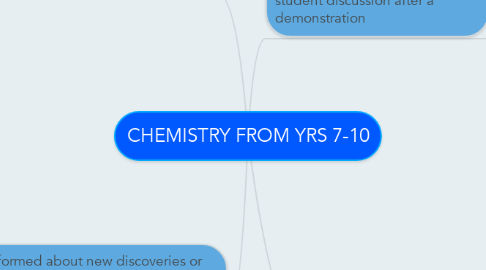
1. Teaching Elements of the Periodic Table using an interactive and applied approach
1.1. iPad App: The elements
1.1.1. A very nice iPad app which is highly inteactive, filled with an abundance of information for each element
1.2. YouTube: Periodic Videos
1.2.1. can be used to engage students by showing them dangerous reactions or rare elements that are not available at schools
1.2.2. supplies a new perspective of chemistry
1.2.3. Some videos talk about very advance topics of chemistry and can be to cater for those who deepen their chemistry knowledge
1.3. SAMR: augmentation
1.3.1. Many of the advantages of using this technology can be done traditionally, however it also incorporates additional functions not normal available in such a setting (e.g. user comments, interactivity and visuals)
2. Keeping students informed about new discoveries or real life scenarios which can be analysed with chemistry topic
2.1. Resource: Reddit/r/futurology
2.2. Resource: Science Daily
2.2.1. Keep up to date with science news and remain at the forefront of scientific discovery
2.2.2. Real life applications of science
2.3. AusVELS
2.3.1. This is one of the key components of teaching science - "science as a human endeavour
2.4. SAMR: substition
2.4.1. Getting students to go to the website and explore the website for themselves is analogous to the teacher telling them the news in class
3. Using collaborative applications such as Google Docs to facilitate student discussion after a demonstration
3.1. Sample demonstrations: YouTube
3.1.1. shows students chemical phenomena which would otherwise be too dangerous/expensive to do in the classroom
3.2. During the live demonstration
3.2.1. students can use technology such as cameras, video recorders, to record the experiment so that they can watch over again
3.3. Google Docs
3.3.1. a means which students are able to write/post their thoughts in a collaborative environment outside of school. (much like the chemistry LA subject, students can be asked to complete different types of analyses e.g. SWOT, mindmapping, answering questions etc)
3.4. SAMR: redefinition??
3.4.1. achieves several levels of SAMR: (S) substitute for students grouping together at school. (A) students from different groups and teachers are able to join in discussion. (M) changes the way students take in information, how it is reordered, viewed and analysed. (R) can possible incorporate the other uses of the internet to make perform a comprehensive breakdown of demonstration
4. Learning about bonding and reactions by using simulations
4.1. PHET applets
4.1.1. very useful way to run simulations
4.1.2. brings key details to the eyes of students and allows for emphasis and experimentation
4.1.3. highly visual for a 'non-visual' subject (electrons, atoms etc)
4.2. AusVELS
4.2.1. Chemical reactions involve rearranging atoms to form new substances; during a chemical reaction mass is not created or destroyed (ACSSU178)
4.3. SAMR: augmentation
4.3.1. substitute for reaction (not a true substitution) but adds extra visual elements and interaction, allowing students to experiment
